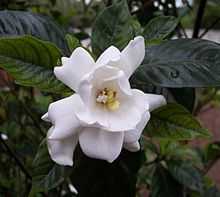Gardenia
| Gardenia | |
|---|---|
 | |
| Gardenia jasminoides | |
| Scientific classification | |
| Kingdom: | Plantae |
| (unranked): | Eudicots |
| (unranked): | Asterids |
| Order: | Gentianales |
| Family: | Rubiaceae |
| Subfamily: | Ixoroideae |
| Tribe: | Gardenieae[1] |
| Genus: | Gardenia J.Ellis |
| Species | |
|
See text. | |
Gardenia is a genus of 142 species[2] of flowering plants in the coffee family, Rubiaceae, native to the tropical and subtropical regions of Africa, southern Asia, Australasia and Oceania.
The genus was named by Carl Linnaeus and John Ellis after Dr. Alexander Garden (1730-1791), a Scottish-born American naturalist.[3]
They are evergreen shrubs and small trees growing to 1–15 metres (3.3–49.2 ft) tall. The leaves are opposite or in whorls of three or four, 5–50 centimetres (2.0–19.7 in) long and 3–25 centimetres (1.2–9.8 in) broad, dark green and glossy with a leathery texture. The flowers are solitary or in small clusters, white, or pale yellow, with a tubular-based corolla with 5-12 lobes (petals) from 5–12 centimetres (2.0–4.7 in) diameter. Flowering is from about mid-spring to mid-summer and many species are strongly scented.
Selected species
- Gardenia anapetes Smith
- Gardenia brighamii H.Mann - Nānū (Hawaiʻi)
- Gardenia buffalina (Lour.) Poir. in J.B.A.M.de Lamarck (= Genipa buffalina)
- Gardenia carinata India, Malaya.
- Gardenia cornuta (Natal Gardenia). South Africa.
- Gardenia flava (Lour.) Poir. in J.B.A.M.de Lamarck (= Genipa flava)
- Gardenia fortunei Eastern Asia.
- Gardenia gummifera India. Small tree, to 3 m high.
- Gardenia imperialis Tropical Africa. Small tree to 12 m.
- Gardenia jasminoides (Common Gardenia, Cape Jasmine or Cape Jessamine). Southern China and Japan.
- Gardenia latifolia India. Shrub or tree, 5–10 m high.
- Gardenia mannii H.St.John & Kuykend. (Hawaiʻi)
- Gardenia remyi H.Mann (Hawaiʻi)
- Gardenia resinifera Roth (Brilliant Gardenia, Cambi Resin Tree, or dikamali) India. Shrub or small tree, to 3 m high. (= G. lucida, Genipa resinifera)
- Gardenia resiniflua (Gummy Gardenia). South Africa.
- Gardenia rutenbergiana (Baill. ex Vatke) J.-F.Leroy (= Genipa rutenbergiana)
- Gardenia scabrella far north Queensland- used in amenities plantings in Cairns
- Gardenia spatulifolia South Africa.
- Gardenia taitensis (Tahitian Gardenia, Tiare māori). Polynesia.
- Gardenia ternifolia (Large-leaved Transvaal Gardenia). Sudano-Zambezian savannas and woodlands.
- Gardenia ternifolia ssp. jovis-tonantis (Welw.) Verdc. (= G. jovis-tonantis, Genipa jovis-tonantis)
- Gardenia thunbergia (White Gardenia, Forest Gardenia, or witkatjiepiering) South Africa. Shrub or small tree, 2–5 m high.
- Gardenia tubifera (Golden Gardenia). Southeastern Asia. Small tree to 15 m high.
- Gardenia turgida India. Shrub or small tree to 4 m high, with spines.
- Gardenia vitiensis (Fijian Gardenia) Fiji.
- Gardenia volkensii (Transvaal Gardenia or Savanna Gardenia). Tropical Africa.
Cultivation and uses
Gardenia plants are prized for the strong sweet scent of their flowers, which can be very large in size in some species.
Gardenia jasminoides (syn. G. grandiflora, G. Florida) is cultivated as a house plant. This species can be difficult to grow because it originated in warm humid tropical areas. It demands high humidity to thrive and bright (not direct) light. It flourishes in acidic soils with good drainage and thrives on [68-74 F temperatures (20-23 C)] during the day and 60 F (15-16 C) in the evening. Potting soils developed especially for gardenias are available. G. jasminoides grows no larger than 18 inches in height and width when grown indoors. In climates where it can be grown outdoors, it can attain a height of 6 feet. If water touches the flowers, they will turn brown.[4]
In China and Japan, Gardenia jasminoides is called zhīzi (栀子) and kuchinashi (梔), respectively. Its blossom is used as a yellow dye, used on fabric and food (including the Korean mung bean jelly called hwangpomuk). Its fruits are also used in traditional Chinese medicine for their clearing, calming, and cooling properties.[5]
In France, gardenias are the flower traditionally worn by men as boutonnière when in evening dress.
Sigmund Freud remarked to the poet H.D. that gardenias were his favorite flower.[6]
It is the national flower of Pakistan.
Several species occur on Hawaii, where gardenias are known as naʻu or nānū.
Crocetin is a chemical compound found in gardenia fruit (Gardenia jasminoides Ellis). In high concentrations, it has protective effects against retinal damage in vitro and in vivo.[7]
Gallery
-

Gardenia brighamii
-

Gardenia jasminoides 'Plena'
-

Gardenia jasminoidesl 'Radicans'
-

Gardenia psidioides
-
Gardenia taitensis
-

Gardenia thunbergia by Edith Struben (1868-1936) -
Gardenia volkensii flower
-
Gardenia volkensii flowers, foliage, fruit
See also
References
- ↑ "Genus Gardenia". Taxonomy. UniProt. Retrieved 2010-02-13.
- ↑ "WCSP". World Checklist of Selected Plant Families. Retrieved 2010.
- ↑ Ellis, John (1759). "An Account of the Plants Halesia and Gardenia: In a Letter from John Ellis, Esq; F. R. S. to Philip Carteret Webb, Esq; F. R. S." Phil Trans R Soc 1759 51: 929-935.
- ↑ Reader's Digest. Success with House Plants. The Reader's Digest Association, Inc. New York/Montreal. 217
- ↑ http://www.sacredlotus.com/herbs/get.cfm/chinese_herb/zhi_zi_gardenia_cape_jasmine_fruit
- ↑ H.D. (Hilda Doolittle). "Tribute to Freud." New Directions, Boston 1974 p11
- ↑ Yamauchi, M; Tsuruma, K; Imai, S; Nakanishi, T; Umigai, N; Shimazawa, M; Hara, H (2011). "Crocetin prevents retinal degeneration induced by oxidative and endoplasmic reticulum stresses via inhibition of caspase activity". European Journal of Pharmacology 650 (1): 110–9. doi:10.1016/j.ejphar.2010.09.081. PMID 20951131.
External links
| Wikimedia Commons has media related to Gardenia. |


